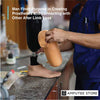Former Pilot and Double Amputee Neal V. Loving’s Memoir is Re-released in Time for Black History Month
Born in Detroit in 1916, Neal V. Loving couldn’t have dreamed that he would become the first Black American and the first double amputee to be licensed as a racing pilot. The Army Air Corps didn’t accept Black aviators back then, so he shifted his focus to aeronautics engineering.

However, Loving constructed his own glider in 1936 and flew a plane for the first time in 1938. And during World War II, Loving helped found an all-Black squadron of the Civil Air Patrol, a volunteer training program for young pilots.
The article below is adapted from an excerpt from Loving’s memoir, Loving’s Love: A Black American’s Experience in Aviation. Originally published in 1994, Smithsonian Books have re-released the memoir in time for Black History Month.
The day that changed Loving’s life
On Sunday, July 30, 1944, Loving took off on a routine training mission for the Civil Air Patrol. However, he found himself in a disastrous crash. Upon regaining consciousness, he saw that his feet had twisted 90 degrees and his right eye had come out of its socket.
After what seemed like a long time, a medical truck arrived, and he was loaded onto a stretcher. The truck took Loving to St. Joseph Hospital in Mount Clemens, Michigan, about nine miles from where the crash occurred.
After surgery, a heavily sedated Loving thought everything felt normal except for a slight tingling sensation. He found out much later that the doctors had amputated his left leg.
On not immediately feeling that he had lost his leg, Loving wrote:
“When a patient loses a limb, there is no immediate, innate sense of physical loss. The nerves from the stump to the brain continue sending normal messages. Only when the stump becomes visible does the patient realize the loss.”
A glimmer of hope
A young, slightly overweight salesman visited Loving in the hospital one day. He wore a prosthetic leg but had just climbed three floors to reach Loving’s room. This inspired and convinced Loving that he could live as normally as possible with a prosthetic leg. According to Loving, the salesman was much more convincing than the hospital staff.
Seeing that there was someone else he could talk to, Loving asked the salesman questions about the amputee life. He asked if he could still drive a car or climb a ladder. And the salesman assured him that a reasonably normal life was possible with his company’s prosthesis.
However, that glimmer of hope didn’t last long. In December 1944, the doctors informed him they needed to amputate his right leg after the shin-bone fractured completely during another surgery. Despite his misgivings and an estimated 50-50 chance of survival, Loving underwent a second amputation.
Preparing to live as a double amputee
Loving wrote that he began preparing to live as a double amputee immediately after the surgery. He drew inspiration from reading accounts of Douglas Bader, a combat fighter pilot who served during World War II after undergoing a double amputation.
His first task was to build up his strength for the long, painful process of re-learning to walk. At that time, there were no physical therapy programs for amputees. So, under the guidance of his healthcare team, Loving tried to get as much exercise as possible while seated in his wheelchair and lying on his bed.
Loving was finally discharged from the hospital on Valentine’s Day in 1945, six months after the accident. He then arranged to visit the Fidelity Orthopedic Company, where he met with the salesman who had seen him at the hospital. While discussing his prosthetic limb options, Loving wrote that he discovered one of the few advantages of being a double amputee—deciding how tall he wanted to be and what shoe size he wanted to wear. However, he chose to retain his height and shoe size, so he didn’t have to overhaul his wardrobe.
Fitting for prosthetic limbs
The first step to getting his prosthetic legs was to shrink his residual limbs to their natural size. This entailed wrapping his residual limbs with a wide elastic tape he wore daily for a month. When his residual limbs were stable, the painful process of fitting his new legs began. Fitting took about three weeks to complete.
Every day, Loving walked around his house to get used to his new legs and build strength. He wrote that he wore the prostheses despite severe pain, particularly when water blisters formed on his residual limbs. His perseverance paid off as he gradually gained strength and skill. And within a few weeks of walking around the house, Loving attempted to venture outside with the help of his crutches. He walked from the house to the front sidewalk and back. While the distance seemed insurmountable, Loving completed his first baby steps.
Rediscovering his love for flying
According to Loving, the news of his progress must have reached Detroit City Airport because he soon heard from Telford Duncan, who owned a flight training school. Duncan invited Loving to visit the hangar, and the latter agreed.
Loving decided to confront his fear of flying again after the hangar visit. He realized the only way to find out whether he was afraid to fly again was to fly a plane. So, Loving asked Duncan for a test flight.
After a short flight within the airport area, Loving successfully landed the plane with Duncan by his side. It was when he realized that the emotional scars from the trauma of the accident that might destroy his love for flying never materialized.
If you’d like to order the book, please visit Smithsonian Books.










































































